In Alaska, fishing industry drives conservation and protects fisheries
In Alaska, fishing industry drives marine conservation:
An interview with Dave Benton of the Marine Conservation Alliance
Rhett A. Butler, mongabay.com
July 24, 2007
Alaska’s fisheries are some of the richest in the world, with fishermen harvesting hundreds of millions of dollars’ worth of salmon, crab, herring, halibut, pollock, and groundfish every year. However, such bounty has not always been the case. Over-exploitation and poor fisheries management in the 1940s and 1950s took a heavy toll on the industry. It was only through drastic measures adopted with statehood that saved the commercial fishing industry in Alaska from collapse, though tough times again plagued fishermen in the 1970s as more boats and increasingly efficient gear depleted catch levels to record lows. Permit systems and reserves helped the industry recover in the late 1970s, a trend that has continued to the present.
Born of this difficult origin, today Alaska sets the bar in fisheries management. Unusually for natural resource management, industry is leading the way, relying on dialog with scientists to determine catch levels and where to designate “no-fishing zones”, while pushing for certification standards for sustainable seafood products. These efforts are coordinated by the Marine Conservation Alliance (MCA), an industry-backed nonprofit based in Juneau, Alaska. In pushing for responsible long-term management of Alaskan fisheries, MCA seeks to preserve species and their habitats for future generations. In so doing, the group advocates for the establishment of marine reserves, promotes sustainable seafood products, and calls for careful monitoring and strict law enforcement.
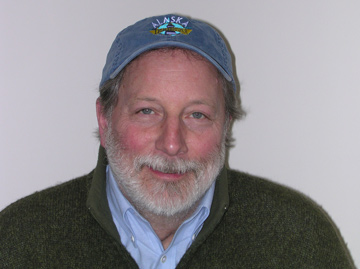
Dave Benton |
In July 2007, David Benton, executive director of the Marine Conservation Alliance, spoke with mongabay.com about MCA’s work in Alaska. Benton, currently based in Juneau, Alaska, has worked on fisheries issues for more than 30 years, first with the environmental movement but later with virtually all facets of the industry, including Alaska Native organizations, fishing groups, local governments, and the Alaska Department of Fish and Game. He has also served on the North Pacific Fishery Management Council for nine years.
Mongabay:
What exactly is the Marine Conservation Alliance?
Benton:
The Marine Conservation Alliance represents around 70 percent of the fishing industry that harvests groundfish and crab in Alaska. We have processors, harvesters, communities, Alaska Community Development Quota (CDQ) groups. It’s a pretty wide-ranging organization that was formed less than a decade ago. It was an attempt by the industry to deal with conservation issues here in Alaska. Now it’s grown into an organization that not only advocates for the industry but advocates for practical solutions to real world conservation problems on a national level as well.
We’ve taken a different approach than some in the seafood industry in the rest of the country; we’re promoting very strongly what people call the “Alaska model” where scientists set the overall catch level. The councils have to live within the recommended limits set by the scientists.
We also have a cooperative research program that we run with universities and NOAA. We get the scientists together with the fishermen to work on issues like bycatch or habitat. One current project aims to reduce salmon bycatch among pollock fishermen in the Bering Sea. Another one works to cut halibut bycatch in the Gulf of Alaska trawl fisheries. The program is also looking for ways to minimize the impact on North Pacific Right Whales and gear modifications to reduce damage to habitat by trawl operations. We also have what is perhaps the country’s largest private marine debris cleanup program. We form partnerships with local groups and communities to clean-up Alaska shorelines. We have recovered hundreds of tons of debris, and are looking into recycling as well.
Mongabay:
Could you elaborate on the salmon bycatch issue?
Benton:
On a pound for pound basis, salmon is more valuable than pollock, but if you are fishing for pollock you don’t want to be catching salmon. There’s a perception issue — people don’t want to be wasting seafood with bycatch. There’s a lot of pressure from villages where salmon is an important way of life. These guys don’t want the pollock industry to be catching salmon.
The pollock fishermen agree, even though salmon bycatch is such a small part of the catch. The pollock fishery is one of the cleanest in the world, about 98 % pollock. Salmon bycatch accounted for less than one tenth of one percent of the pollock catch by weight. So we are looking at a couple of possible ways to improve that record. We’re conducting tests with modified gear using an excluder panel that would allow salmon to swim out of the net. We’ve also putting some depth and temperature sensors on the net to see if depth and temperature could be used to avoid salmon but not pollock. We don’t have the solution yet, but we are hopeful that one or both of these techniques can help reduce the incidental catch of salmon.
Mongabay:
Regarding the issue of sustainability. Has industry decided that sustainability is good for its long-term health?
Benton:
That’s exactly the perspective.
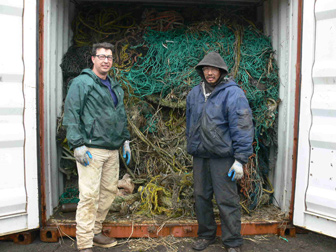
Image coutesy of NOAA’s Alaska Fisheries Science Center |
The philosophy grew out of a group of fishermen who watched how the foreign operators here just hammered the resources before the 200 mile limit. A lot of the pioneers were also salmon fishermen who remember the collapse of the salmon runs in the 1940s and 1950s under federal management. Once statehood occurred and Alaska got control, fishermen were facing some pretty hard times. The state had to shut down most of the salmon fisheries to rebuild the runs.
The folks who went through that were the ones who pioneered the emerging industry when the Magnuson Act went into place in the 1970s. So in Alaska we’ve had a long run of having the industry rely on science to make sure that resources are there for the long term. That said, everyone knows there is uncertainty out there. You can’t know exactly what’s going to happen in the ocean, but the important thing is that when the scientists say it’s time to cut a quota, industry knows it is the right thing to do. Of course there are always a few naysayers but they don’t win out in the end.
Mongabay:
Why is this working in Alaska but not other places?
Benton:
That’s a good question. I tend to think it’s the way the industry has evolved here in Alaska. On the East coast for example, there has been a lot longer time frame — in the early days fishermen had to figure out ways to skirt the King’s rules which were in place only to serve the King’s interests, there’s more resentment from industry toward regulation. Here in Alaska, fishermen experienced though times in the 1940s and 1950s. They saw what happens when you don’t take care of the resources. Because the industry developed in the face of these challenges, it has a conservation ethic.
Mongabay:
How does it work? What is done to make it sustainable?
Benton:
The first step is having a good stock assessment program coupled with good scientific advice and a willingness to work within that framework. This means regular assessments, and steady funding.
The second order of business is having a rigorous monitoring and enforcement program so everyone knows what the rules are and understands that if they don’t play by the rules there will be consequences. For example Alaska has one of the world’s largest observer programs to monitor the catch. We have NOAA and the Coast Guard out there to make sure everyone follows the rules and to catch violators.
The third deals with operations within the industry. The seafood business up here has been moving toward what we call “rationalized fisheries” like the Halibut-Sablefish Quota program or the co-ops for pollock in the Bering Sea. Those kind of programs require the industry to adapt, but they give real opportunity for the individual operator or fisherman in a cooperative manner to manage their operation to be more efficient, cleaner ( i.e. less bycatch), and less wasteful. It really makes a big difference. The industry here is self-regulating and trying to become more of a good corporate steward. To me, those are the elements you need to be sustainable. The record shows that if you give industry the tools and the right incentives, it will come through and support sustainability.
Mongabay:
How much does the end consumer come into play with these approaches?
Benton:
At the end of the day the consumer is a very important component of what’s going on here. The industry pays very close attention to what’s going on in markets. Getting a quality product to consumers, and consumer acceptance is key to industry.
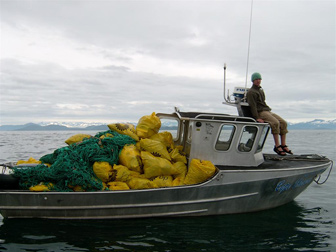
Transporting marine debris from an island in Prince William Sound, Alaska |
For example, the Halibut-Sablefish Quota program has really delivered for consumers. It used to be that the only time you could buy fresh halibut was a few weeks here and there and the rest of the time it was frozen. Now you can buy fresh halibut all year around. It’s a really great product. The fishermen take a lot better care of the fish when they come aboard. It makes all the difference.
Similarly the pollock industry pays huge attention to its markets. And the coop structure allows the industry to produce a superior product.
The trend towards certification — for example getting the Marine Stewardship Council (MSC) label and looking at the Sea Food Watch List from the Monterey Bay Aquarium — and moving toward sustainable seafood is a market bonus. This isn’t lost on folks up here — we got in that game early, which was a big advantage.
Alaska Pollock, Halibut-Sabelfish, and Salmon are all certified by MSC. So I think industry is really paying attention to sustainability as a market tool.
Mongabay:
Now that more than half of Alaskan fisheries are sustainable, what’s the next step?
Benton:
Right now I would have to say that all of Alaska’s seafood are being produced on a sustainable basis. There are no overfished stocks of fish. And because Alaska produces over half the nation’s fish, that is good news for the entire country. But there are challenges. I’d like to see more progress in other parts of the country, but frankly the fisheries management councils are doing a pretty good job improving their conservation record.
One of the interesting issues to me is habitat protection. I noticed in that interview you did with Mike Sutton from the Monterey Bay Aquarium, he said that marine conservation lags way behind conservation on land. So I went back and looked, and I’d have to disagree. In June our council voted to close a pretty sizeable area in the northern Bering Sea to bottom trawling in order to protect habitat and wildlife, including whales, walrus, and seals. At that same meeting we also started the process of closing the entire Arctic Ocean to fishing until we have a plan for how to address climate change issues up there. Two years ago the management council closed a very large area out near the Aleutian Islands, and we had already closed off about 100,000 nautical miles in the southern part of the Bering Sea in the early 1990’s. When you add it all up, it’s more than 650,000 square nautical miles. That’s between 5 and 6 times the total acreage of the entire National Park system for the United States.
Mongabay:
You mention climate change. Are you taking steps to prepare for potential changes?
Benton:
Up in this part of the world, it’s pretty visible that there is some warming going on out in the ocean. Fishermen will tell you they are seeing a more northerly progression of species. If you look at satellite data on a time series you can definitely see a shrinking and thinning of the ice pack at higher latitudes.
The industry in Alaska is looking more than a year or two into the future, and adapting to changing environments or changes in fish stocks. Climate change is one of those factors. That’s why we pushed our council to do things like close the Arctic Ocean until we understand what’s going on. The northern Bering Sea seems to be the transition zone for these changes. The key is good science and getting ahead of the information curve so you can plan ahead as best as possible.

Loading a container with marine debris removed from the beaches of St Paul Island, one of the Pribilof Islands in the Bering Sea |
The seafood industry and the management council also work with the North Pacific Research Board, a science body — I sit on the board. The research group just linked up with the National Science Foundation to fund a roughly $50 million project to characterize and model the Bering Sea ecosystem and how its being affected by climate. We’ll be looking at the effects on commercial species and the ecosystem as a whole to develop models so that we can improve management and adapt to climate change. Ocean warming may mean there are challenges or perhaps new opportunities — we just don’t know.
Mongabay:
What’s your biggest challenge? Do you face opposition from both environmental groups and some elements of industry?
Benton:
We get it from both sides. There are industry groups in some parts of the country who have a different philosophy and take a very different approach than we do. They get a little annoyed at times because we do support conservation so strongly — but we really limit ourselves to Alaska and are not going to tell people what to do in their own backyard. It’s an old adage of “Do what you say you’re going to do and people will take what they want from it.” Our hope is that other parts of the country will look at what Alaska does and see that there are some very positive benefits from what we are doing. From the environmental side there are certainly some groups who you can work with, and some where the facts never got in the way of a good story. I think that conservation in the ocean is a really important thing — I’ve made it my career for the past 25 to 30 years — and I think its unfortunate when advocates don’t stick to the facts. It strains credibility and in the end impedes conservation efforts.
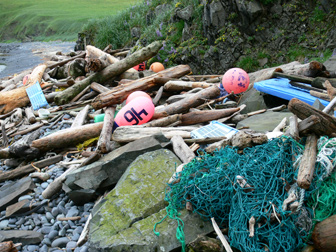
Marine Debris on the Beach in Unalaska (Aleutian Islands) |
Bottom line, there’s a lot of good people in the industry, the scientific community, and the management community who are trying to do the right thing. If you look on a worldwide scale the U.S. is a real leader. We’re doing things here that the rest of the world wished they were doing but are not. There are a few examples abroad that standout as well — New Zealand and Iceland — but by and large, the U.S. is really leading by example. It’s unfortunate when some folks in environmental or conservation groups cannot accept the successes, they just keep going after things without looking into the details and sticking to the facts. That, in my view, gets in the way of real progress. I like practical solutions that have an effect in the water, I’m not real big on rhetoric.
There’s a lot of gloom and doom in the world between climate change and resource depletion and I think that if people focus on practical and meaningful solutions to real world problems, then individuals can make a big difference. For example Alaska, population-wise a small state but with an enormous territory with international concerns, has been able to do a lot. We’ve basically rewritten a lot of the international laws that affects the North Pacific to protect fishery resources, marine mammals, and sea birds. It’s been everyday people of the seafood industry who’ve lead these efforts, which shows that people from all walks of life can make a difference. I think it’s too easy for people to throw up their hands and say the problems of the world are just too big. That’s a big error. We’re showing that while there are challenges, they can be overcome.
Looking to the future, the biggest challenge we face is getting the funding together to implement the laws that are already on the books. We just rewrote the Magnuson Act and we’ve put some significant changes into that law to strengthen conservation. Ted Stevens championed that bill, and pulled a rabbit out of the hat by getting the bill through with all the conservation initiatives it has in it. It’s not unusual for Stevens — he’s led the fight to stop high seas drift nets worldwide, and the fight to close the Bering Sea donut hole, and get the United Nations Convention on Straddling Fish Stocks and Highly Migratory Fish stocks through despite opposition from a lot of other interests in the United States. Stevens has been able work with members from both sides of the aisle to get strong oceans conservation legislation through when it looked lost. He doesn’t always satisfy the rhetorical needs of environmental groups but he has been a leader in ocean conservation.
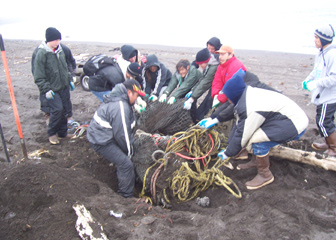
St Paul Islanders remove a trawl net buried in the sand on North Beach (May 2006) |
Today the problem in the Congress, especially the Senate, is that we don’t have enough people like Stevens, or Hollings (D-South Carolina) who retired recently, and Senator Inouye (D-Hawaii). Senior leaders who care about the ocean and can get the funding and the programs implemented. It’s always a seductive thing to pass a law with a lot of grandiose goals, it’s a whole different thing to get it implemented. You can’t fund the basic science programs to get the answers you need to make informed decisions. We really need to focus on that — we’ve got to come up with a long-range funding strategy for basic ocean research if we’re going to conserve resources and manage on an ecosystem-level basis. With the exception of Stevens and Inoye that leadership is just not out there today. We need folks to step up.
Mongabay:
So in your view funding needs to come from the government?
Benton:
I can’t speak for sources for the larger organizations which get funding from foundations like Packard and Pew, who put a lot of money into ocean issues, but mostly on the advocacy side. What I’m thinking about is funding for NOAA scientists, Fish and Wildlife scientists, the academic community, and the whole range of people who go out into the ocean on a scientific basis to get the kind of information we need. We’re looking for the kind of recommendations the Commission on Ocean Policy puts forward, like the concept of an oceans trust fund that is set up in the U.S. Treasury and puts out a regular amount of money that regularly goes toward ocean science programs.
Mongabay:
What are your thoughts on aquaculture? I would assume that since you focus on wild fisheries, MCA doesn’t support fish farming. Is that a fair statement?
Benton:
That’s a fair statement, although our organization has stayed out of the fish farming fight. If you think about quality products for the consumer right now, in terms of Alaskan wild products, there are no fish stocks being over harvested. It’s healthy seafood — no chemicals and no additives. I’d have a hard time advocating for aquaculture products. We strongly support wild products as sustainable and healthy.